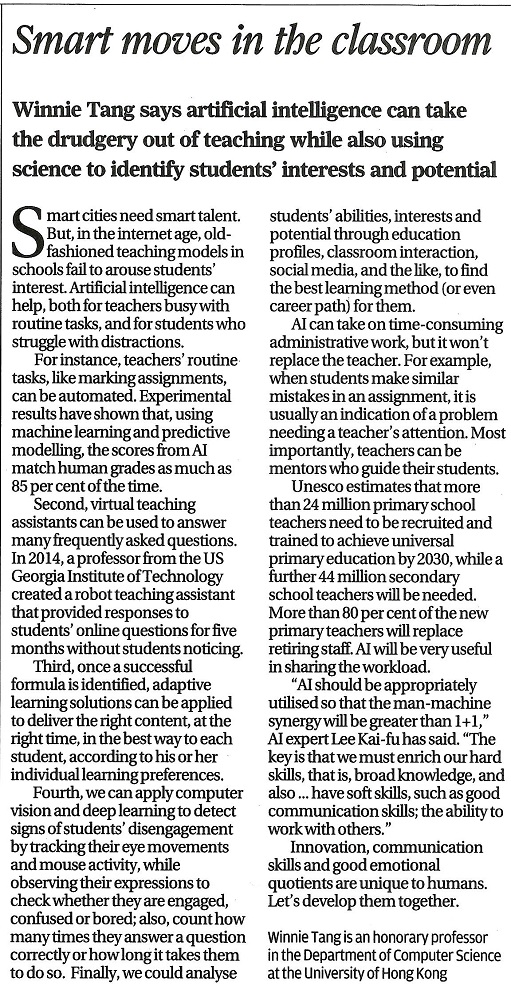網上版請按此

Smart moves in the classroom
Winnie Tang says artificial intelligence can take the drudgery out of teaching while also using science to identify students' interests and potential
Smart cities need smart talent. However, in the internet age, old-fashioned teaching models in many schools fail to arouse students' interest. Artificial intelligence can help, both for teachers busy with routine tasks, and for students who struggle with distractions.
For instance, teachers' routine tasks, like marking assignments, can be automated. Experimental results have shown that, using machine learning and predictive modelling, the scores from AI match human grades as much as 85 per cent of the time.
Second, virtual teaching assistants can be used to answer many frequently asked questions. In 2014, a professor from the US Georgia Institute of Technology created a robot teaching assistant that provided responses to students' online questions for five months without students noticing.
Third, once a successful formula is identified, adaptive learning solutions can be applied to deliver the right content, at the right time, in the best way to each student, according to his or her individual learning preferences.
Fourth, we can apply computer vision and deep learning to detect signs of students' disengagement by tracking their eye movements and mouse activity, while observing their expressions to check whether they are engaged, confused or bored; also, count how many times they answer a question correctly or how long it takes them to do so. Finally, we could analyse students' abilities, interests and potential through education profiles, classroom interaction, social media, and the like, to find the best learning method (or even career path) for them.
AI can take on time-consuming administrative work, but it won't replace the teacher. For example, when many students make similar mistakes in the same assignment, it is usually an indication of a problem needing a teacher's attention. Most importantly, teachers can be mentors who guide their students.
Unesco estimates that more than 24 million primary school teachers need to be recruited and trained to achieve universal primary education by 2030, while a further 44 million secondary school teachers will be needed. More than 80 per cent of the new primary teachers will replace retiring staff. AI will be very useful in sharing the workload.
"AI should be appropriately utilised so that the man-machine synergy will be greater than 1+1," AI expert Lee Kai-fu has said. "The key is that we must enrich our hard skills, that is, broad knowledge, and also ... have soft skills, such as good communication skills; the ability to work with others."
Innovation, communication skills and good emotional quotients are unique to humans. Let's develop them together.
Dr. Winnie Tang
Honorary Professor, Department of Computer Science, The University of Hong Kong